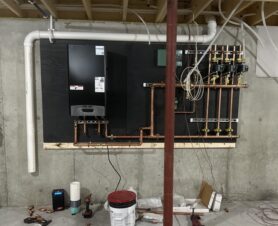With jobsite productivity and safety at the forefront of the construction industry, it’s important to know the innovations that are enabling faster, easier installs for contractors while providing end users with more efficient, sustainable systems.
Check out a few of these solutions that can help make jobs easier and buildings more efficient.
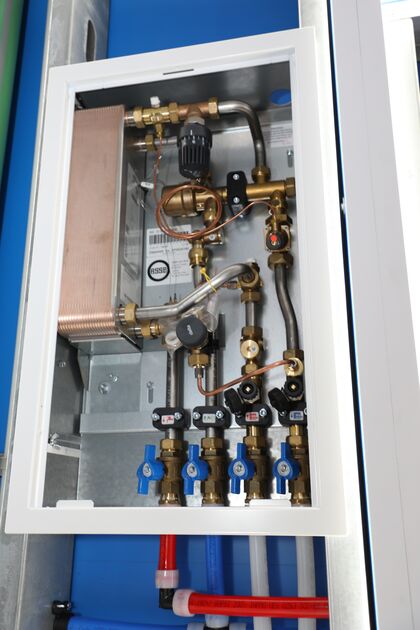
Heat-Interface Units
A first in the North American market, these prefabricated, self-contained, heat-interface units (HIUs) convert a building’s hydronic heating supply to on-demand domestic hot water (DHW).
Ideal in multifamily structures, hospitality buildings, dormitories, assisted-living centers, and healthcare patient towers, these HIUs (sold under the brand name AquaPort™) feature a proportional control valve (PCV) and double-wall heat exchanger to create the DHW from the hydronic heating supply.
This solution removes the centralized DHW and recirculation piping to provide numerous benefits, including energy and water savings, improved water quality, installation efficiencies, reduced maintenance, and reduced risk. The PCV does not require any utility connections and eliminates the DHW heat source, supply piping, recirculation network, pumps, and storage tanks. It also optimizes efficiencies of the hydronic heating supply.
For energy efficiency, it returns the lowest water temperature possible, enabling boiler systems to reach their maximum-rated efficiency. It also provides a more centralized location in an individual unit of a building, which leads to faster hot-water delivery times and reduced water waste, helping to reduce the whole-life carbon for the building.
Compared to traditional pipe-routing methods, incorporating this solution can reduce hot-water energy use by up to 35%, eliminate up to 40% of unnecessary piping, mitigate microbial growth in the DHW system, and remove more than 50% of the total DHW volume in a building for greater sustainability and hygiene.
The compact, in-wall design is only 25.6″ tall by 14.5″ wide and 5.4″ deep to maximize overall square footage, and it is extremely lightweight at 47 lbs. for the 100K BTU/hr. version and 57 lbs. for the 180K BTU/hr. version, which makes it easy for one person to maneuver and install.
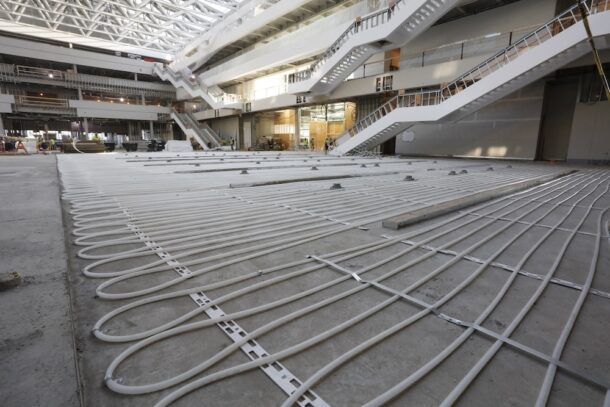
Prefabricated Radiant Mats: Cleveland Health Education Clinic, Ohio | Radiant floor heating install with Radiant Rollout Mats
Introduced into the market about a decade ago, prefabricated radiant mats have become extremely popular in commercial radiant heating and cooling projects, helping to save up to 85% in installation time compared to traditional methods.
Ideal for radiant heating and cooling systems in large commercial spaces as well as turf conditioning, snow and ice melting, and permafrost prevention (cold storage) applications, these mats are customized, prefabricated, and pre-pressurized solutions that are designed and delivered to jobsites to speed commercial installs and maximize radiant system performance.
The mats feature oxygen-barrier PEX pipe, which is a flexible, durable material that protects ferrous components in a radiant heating and cooling system. Some manufacturers also include engineered polymer (EP) connections, which are approved for burial in a slab, that are included in a reverse-return header option. This design can help reduce required manifold ports by up to 80%, helping to save time and install costs.
Since the mats are customized to meet each individual project, the pipe sizes, loop lengths, and on-center spacing varies depending on the design. Once the mats arrive on the jobsite, installers simply move the mats into place, cut the zip ties, unroll the mats into place, and fasten.
The mats also can reduce fastening hardware by up to 40%, further increasing installation efficiencies and jobsite safety. Best of all, pre-pressurized piping and self-balancing circuits provide dependable commissioning and system startup for a seamless transition from installation to end use.
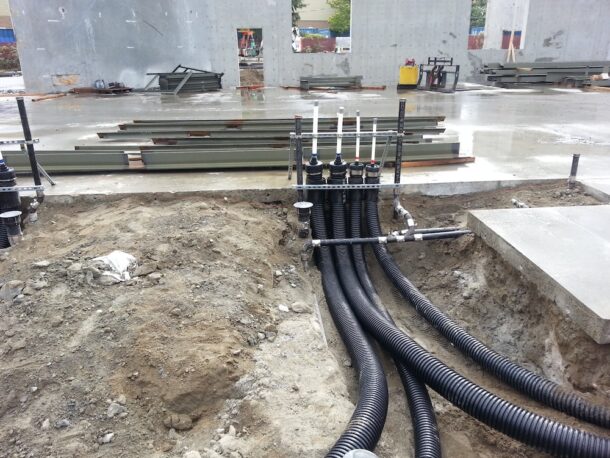
Flexible Underground Pre-Insulated Piping Systems
When it comes to underground piping distribution for radiant heating and cooling, snow and ice melting, turf conditioning, or permafrost prevention (cold storage) applications, the industry is discovering the benefits of flexible, PEX-based, pre-insulated piping systems, and the solution is beginning to dominate over traditional copper or steel.
With pre-insulated PEX systems, there are typically one or two service pipes surrounded by insulation and covered by a jacket or casing. This type of system offers numerous advantages over rigid systems, such as lighter weights, fewer connections, and significant installation efficiencies.
The lighter weight allows contractors to maneuver the piping around a jobsite much easier, faster, and more effectively with less impact on the body. The piping is also available in long, continuous coils (rather than straight, segmented pieces of rigid pipe), which eliminates the need to dig a straight or level trench (since the coils can curve around existing structures and obstacles). Additionally, longer coils mean fewer (or sometimes no) underground connections for faster installations.
Plus, because the insulation is already added to the pipe, it eliminates the two-step process of installing the pipe and then insulating after installation. All of these benefits add up to significant labor savings and maximum jobsite productivity.
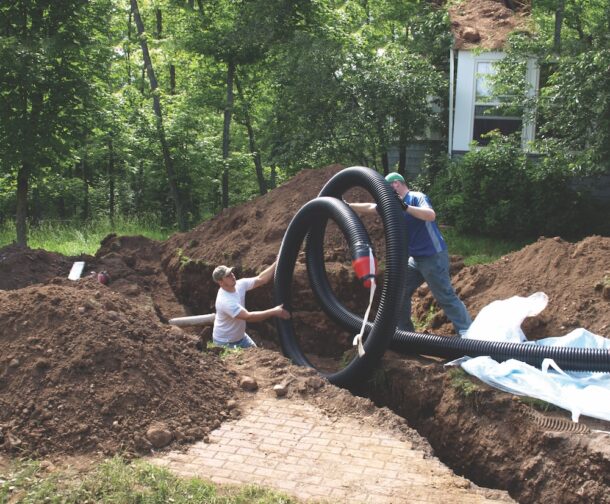
It is important to note that there are two types of PEX-based pre-insulated piping systems: bonded and slip. In a slip system, the PEX service pipe is covered by multilayer polyethylene-foam or PEX-foam insulation and covered by a corrugated HDPE jacket. This design is more flexible because the different layers can move independently. Additionally, if an installer needs to access the PEX service pipe, it’s a much simpler process of cutting away the foam insulation rather than scraping off the glue that adheres the insulation to the service pipe in a bonded design.
When deciding to install a PEX-based pre-insulated system, it is important to understand the thermal performance differences between a single-pipe system and a twin-pipe system. Some code jurisdictions do not allow twin-pipe configurations due to the reduction in insulation thicknesses, which can result in greater heat loss in heating applications. However, because twin-pipe configurations significantly reduce the amount of surface area exposed to the ground, it can have a positive effect on heat loss.
Kim Bliss is the technical and marketing content manager at Uponor. She can be reached at kim.bliss@uponor.com.

